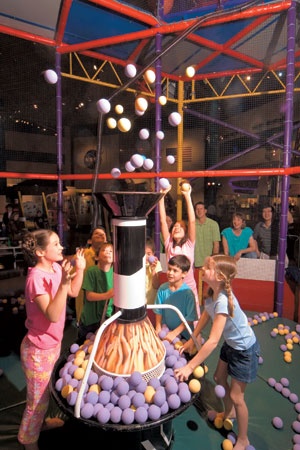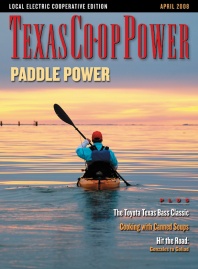So what would your average second-grader—who couldn’t tell Neil Armstrong from a Saturn V rocket—like best about Space Center Houston, the education and entertainment complex next door to the world-famous Johnson Space Center?
Judging from the thundering sneakers and delighted squeals, it’s the spiral chutes and ladders of a whopper five-level indoor space gym—the Martian Matrix—complete with a ball rocket launcher and its own kid-friendly communications system.
On a recent chilly school day, a busload of delighted Houston youngsters were whooping and hollering. Retired Winter Texans were quietly photographing the world’s largest display of moon rocks. And tourists speaking Norwegian and French were watching real space engineers perform microgravity simulations in an actual astronaut training facility.
At Space Center Houston, participation takes precedence over static displays of dusty artifacts, says Roger Bornstein, the center’s director of marketing. “We provide experiences that people do,” Bornstein said. “And people want that experience. They don’t want to be looking through glass.”
Set near Clear Lake amid the pines off Interstate 45 on NASA Parkway, Space Center Houston offers plenty of history and historic artifacts, to be sure. “But when you walk in here, you hear kids laughing, people talking. It’s a place that’s very much alive. Through that activity, we’re able to educate people, adults and children, about the U.S. space program,” said Bornstein.
So bring the whole family and plan to stay awhile: A visit takes 4 to 6 hours, depending on the age and attention span of your group.
Everything starts in Space Center Plaza, where revolving science exhibits with the NASA touch change throughout the year. Just off the main plaza is Starship Gallery, a good place to start your visit in earnest. Narrated by astronauts, “On Human Destiny” is a short film history taking you from Mercury and Gemini to Apollo, the space shuttle and the International Space Station. You’ll hear snippets of President Kennedy’s famous moon speech at Rice University, while film clips and music convey the excitement, pride and (sometimes) tragedy of manned spaceflight.
Afterward, doors open to Space Center Houston’s artifact gallery and exhibits, where visitors can see Apollo mission moon rocks, the impossibly tiny Mercury Faith 7 capsule piloted by Gordon Cooper in 1963, and the Apollo 17 Command Module, which made America’s last lunar voyage in 1972.
Items here range from the serious—a Lunar Roving Vehicle used for moon mission training—to the lighthearted—a toy dinosaur taken into space in honor of the “Raptor Team” trainers who loved testing shuttle astronauts with “dramatic and devastating” mission simulations.
Younger children might most enjoy the “Living in Space” program, which answers those perennial questions about how astronauts sleep, eat and you-know-what in zero gravity.
Elsewhere in “The Feel of Space” area, popular computer simulators let visitors try their hand at landing and docking a space shuttle.
Children and adults alike will also like the rumbling “blast off” feature of Blast Off Theater, with its live presentation on the future of spaceflight. You might even get to eavesdrop on a live space shuttle mission or see live feeds from the Neutral Buoyancy Laboratory, where astronauts train underwater.
But for serious space buffs, a visit to Space Center Houston has to include the tram tour of Johnson Space Center, “the home of manned spaceflight,” where men and women of the U.S. space program work and train. Here on this 1,600-acre scientific campus, flight controllers monitor space shuttle missions, astronauts prepare for life on the International Space Station, and that unassuming engineer waiting to cross the street could be contemplating upcoming missions to Mars.
Stop No. 1 is usually Building 30N, which houses the historic Mission Control Center, a National Historic Landmark and the actual room from which space engineers and scientists coordinated Apollo 11 and man’s first moon landing. Docents tell the story of that “one small step … one giant leap,” while monitors provide a sneak peek into the modern Mission Control Center, where scientists and engineers are on continuous duty overseeing American visits to the International Space Station.
A final tram stop is usually Rocket Park, home to the largest rocket ever built by NASA, and one of the only remaining Saturn V rockets in existence. This recently restored, 363-foot behemoth was originally built for a canceled Apollo mission, which explains why it is lying in a climate-controlled shed in Houston rather than floating in space in huge, discarded chunks. By the time the docent has explained the function of each rocket section, down to the final, relatively tiny tip that held the crew, even kids can appreciate the incredible effort and power it takes to propel humans to the moon.
“What we try to do is make sure everybody leaves here with some degree of knowledge about the space program,” Bornstein said. “We want everybody to have some appreciation for the work of NASA in extraterritorial exploration. It’s one of the most important things our country does.”
——————–
For more information about Space Center Houston, visit www.spacecenter.org or call (281) 244-2100.
Karen Hastings, who wrote about quinceañeras in the June 2007 Texas Co-op Power, has relocated from South Texas to Katy, near Houston.


